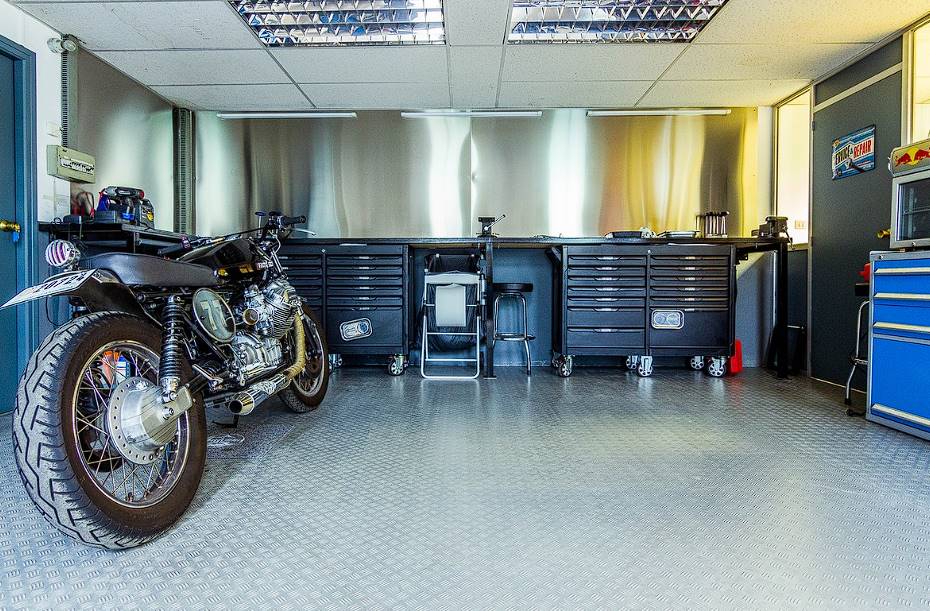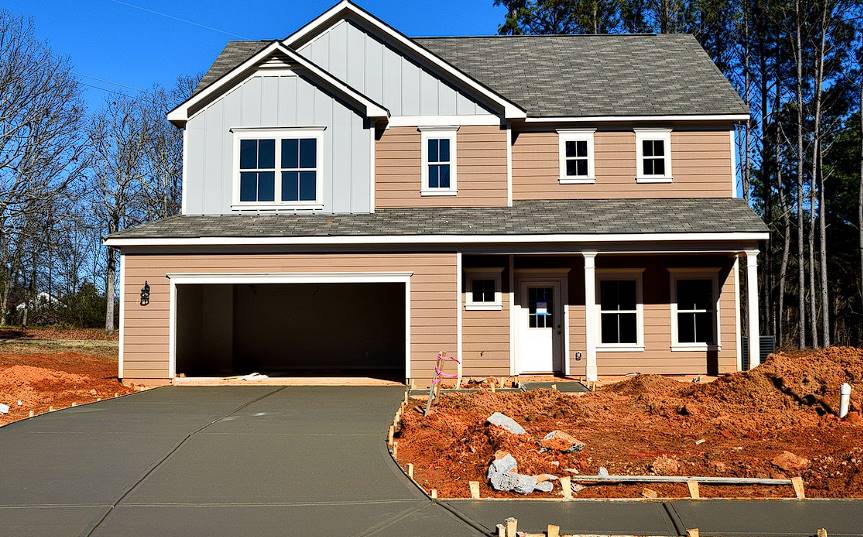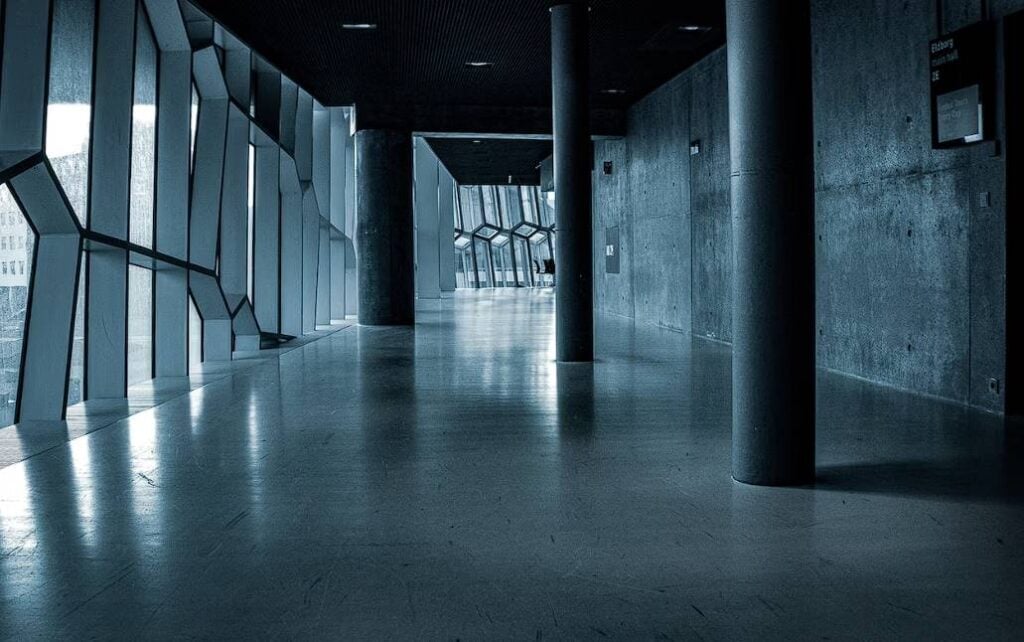If you aim to enhance your garage's style and visual appeal, focusing on the floor is a great starting point. While standard concrete slab garage floors serve their functional purpose, with a little extra effort, they can become not only attractive but also comfortable.
Perhaps you're wondering, "Where should I begin?" If that's the case, you've come to the right place! In the following discussion, we'll explore various flooring options based on their suitability for different uses, the frequency of traffic, and the materials involved. Considering these factors, you can make an informed decision instilling confidence. Whether you have a residential, commercial, or aircraft hangar garage, options are available to meet your needs.
Regarding garage floors, you'll discover that most materials perform pretty well. However, there are specific considerations to keep in mind to avoid potential pitfalls. Repairing any cracks or damages in your concrete floor is highly recommended, especially if vehicles regularly traverse the surface. Additionally, it's crucial to rely on something other than a wooden base for your garage floor, as it simply lacks the strength to support the weight of your vehicles, tools, and other stored items. If you opt for floor paint, use specialized garage floor paint, as other types of paint will simply flake off and prove ineffective.
How to Choose the Best Garage Floor Coating
When selecting new flooring for your home, the usual contenders like the living room, foyer, and kitchen often take precedence. However, it's essential not to overlook the significance of choosing the right flooring for your garage. Ensuring you have the appropriate floor type and using products specifically designed for it are crucial considerations. Additionally, keeping the size of your garage in mind is essential to avoid overspending on unnecessary materials and to save money.
On the other hand, it's equally important not to underestimate the amount of product you will need. Take note of the dimensions of your garage floor and calculate the quantity of materials accordingly. This will help you stay supplied with supplies mid-project.
Furthermore, starting the flooring project is advisable only after you have ensured the floor is prepared correctly. Cleaning the garage floor is a simple yet essential step that should be noticed. Concrete floors, being porous, can appear clean but may harbour hidden dirt and grime, which can make painting over them quite challenging.
We recommend using a pressure washer to remove as much dirt as possible thoroughly. Alternatively, you can use a scrubbing brush and warm, soapy water, although this method may take longer to achieve similar results.
To help you make the most informed decision and maximize the potential of your garage floor, we have compiled a collection of the best garage floor ideas.
Epoxy Coating
An epoxy coating is one of the most popular ways to finish a garage floor. It is known for being very strong, resistant to a wide range of chemicals, and able to keep its shine after it has been installed. Epoxy coating has been known to last up to 3 years in high-traffic commercial areas and much longer in a home garage.
On the other hand, if you like to do things yourself, you should do something other than installing epoxy. If epoxy flooring isn't put down correctly, it can get wet underneath and not stick well to the concrete floor.
Covering Options: Tile and Mats
The other primary category of floor coverings consists of movable or removable building materials placed on top of the garage floor and can be done when necessary. You are free to cover your garage floor with any carpet or other material you like; this front has no restrictions.
You will need a product designed specifically for garage floors; however, if you want a surface that is durable enough to withstand the wear and tear that comes with daily use of the garage. A few products on the market fit this description, including floor tiles and floor mats.
Solid Concrete Flooring
Concrete floors are a familiar idea. Concrete has been around since the 1800s. But since 2020, this durable, elegant, hard-wearing, and easy-to-clean material has steadily become more prevalent in modern and traditional home designs.
The best choice for your garage floor is concrete. Solid concrete flooring is the best for a garage floor because it is strong, heavy, and easy to clean and care for. The garage floor has to withstand a lot of pressure and general wear and tear. It should be as solid and heavy as possible and able to handle the weather outside.
Floor Paint
Concrete floor paint is an easy way to cover up oil, grease, and rust stains on a garage floor and give it a fresh new look. Both latex and oil paints are suitable for use on concrete floors. They are constructed with a satin, non-slip finish to hold up under high foot traffic and to withstand the damaging effects of solvents, salts, and other acidic supplies.
Epoxy resin is found in small amounts in some latex floor paints, giving them a tough and stain-resistant finish. Make sure the paint you buy specifically says it is suitable for use on concrete floors. Instead of using regular paint, you can use these products on your garage floor instead.
Garage floor paint is found in three primary varieties:
- The least expensive choice is regular concrete paint, which comes in various colours. It's made for garage floors that get a lot of use and is more challenging than standard paint, but it's also the least durable. It's a good choice if your garage needs to be cleaned up. Types made of acrylic can be cleaned with soap and water.
- Popular epoxy garage floor paint is a tough finish that can withstand chemicals, oil, gasoline, and scratches. Most of the time, putting on an epoxy finish is a multi-step process that starts with mixing the base product with a hardener. Some companies have made the product easier to use so that it can be used straight from the can.
- Polyaspartic formulations mix urethane with other ingredients to make thick finishes harder and more resistant to heat and chemicals than epoxy paints. They cost more money as well. Fast curing times can make it hard for the average DIYer to use these finishes.
PVC Interlocking Tiles
One of the best and cheapest ways to give your garage floor a new look? By putting some interlocking floor tiles. People like floor tiles that fit together. Value interlocking floor tiles are affordable because they are made from recycled materials and have a high-quality finish.
All tiles come with simple steps anyone can follow, even if they have never done it before. Overall, PVC floor tiles that snap together are strong and will protect your floor from oil and chemical spills. If you want to use your garage as a detailing or wash bay, where there will be a lot of water, we suggest using floor tiles with holes so the water can run away.
To cut the tiles to the right size, you'll need a rubber mallet, a tape measure, and a chainsaw. Most tiles are dry-laid, and their weight keeps them in place, so the tighter they fit, the better.
Here are some other tile options:
- Rubber tiles are like connected tiles often used in sports facilities, kids' playrooms, and other places. They are solid and comfortable to walk on, which makes them an excellent choice for people who spend a lot of time in a garage workshop.
- Wood composite tiles like DRICore, often used as a base for carpet and other floor coverings, may also serve as shed flooring. These 2-foot-square panels can hold a lot of weight, which makes them suitable for garage floors. The tongue-and-groove sides fit together quickly, and where the floor meets the garage door, a transition strip is needed.
Vinyl
Today, the market is full of modern, stylish, and long-lasting vinyl flooring designs that are usually easy on the wallet. Vinyl is one of the cheapest types of flooring, along with laminate. It is also very good at insulating both heat and sound. When it comes to fitting, vinyl flooring is the best choice. Vinyl flooring is an artificial material that you can put on top of your old flooring to hide dents or bumps.
Floor Mats
Rolling out rubber or polyvinyl plastic mats is the best way to cover a garage floor. Like garage floor tiles, mats can be placed on slightly stained or cracked concrete floors without prep work.
Some mats look like rugs, while others have different textures or look like padding gym mats. Most of the time, mats made of materials that are easy to clean and thick enough to protect your feet will be the best choice for a garage.
Pick Studded PVC Flooring
Rubber flooring is popular in places with a lot of foot traffic, like a garage, because it is durable, modern, and functional.
This flooring is also straightforward to put in. Just roll it out on the floor and trim the ends to make a smooth finish. The studs on the surface of PVC give the floor a lot of grips, making it a good choice for a garage or workshop.
Porcelain Tile
Even though it might not seem like it, porcelain floor tile is one of the most complex and lasting flooring options. Ceramic tiles are strong enough to hold even the heaviest cars. Tile comes in a wide range of colours and shapes and doesn't cost too much. Porcelain tile is a good choice for a garage slab.
Repair and Preparation Concerns
Coatings and coverings for garage floors shouldn't be seen as a way to put broken slabs "out of sight, out of mind." If you properly fix and prep a cracked or broken slab, most finishes, especially paint and cement, will stick well.
Oil and grease spots on the concrete will almost always show through a floor coating. And no coating or covering for the garage floor will solve the wetness problem. Before you put down a coating or covering on your garage floor, you should fix any damage, spots, or moisture problems.
Consider insulating the concrete slab if you want to turn your garage into a living place or make it more comfortable. The best way to insulate a garage floor is to lay sleeper strips and rigid foam insulation over it, then cover it with plywood pieces and your flooring choice.
Which Option Is Right for You?
Quick fix
A quick and cheap way to update concrete is to paint or stain it. Are you preparing to sell your home? This is a safe choice.
Normal use
Concrete paint, stain, and dye are good options for covering cars, lawn tools, and small home improvement jobs. Upgrade to an epoxy finish to make the results last longer.
Home gym conversion
Go with sheet vinyl or tough rubber.
Playroom conversion
For the kids, choose rubber floors.
Mother-in-law apartment
Acid stains are pretty and fun, but add non-slip substances or put down area mats to keep your feet from slipping.
Mechanic's shop
Think about plastic or ceramic tiles if you want something that will last and is easy to clean.
Conclusion
The most important details in this text are the types of flooring options available for a garage, their suitability for different uses, the frequency of traffic, and the materials involved. It is important to repair any cracks or damages in the concrete floor, rely on something other than a wooden base, and use specialized garage floor paint. When selecting new flooring for a home, it is important to consider the appropriate floor type and products specifically designed for it, as well as the size of the garage and the amount of product needed. Cleaning the garage floor is an essential step that should be noticed. The most important details in this text are the five most popular garage floor ideas: epoxy coating, tile and mats, solid concrete flooring, and floor paint.
Epoxy coating is known for being strong, resistant to chemicals, and able to last up to 3 years in high-traffic commercial areas. Tile and mats are movable or removable building materials placed on top of the garage floor. Solid concrete flooring is the best choice for a garage floor because it is strong, heavy, and easy to clean and care for. Floor paint is an easy way to cover up oil, grease, and rust stains on a garage floor. Garage floor paint is a great way to give your garage floor a new look.
There are three primary varieties of garage floor paint: regular concrete paint, epoxy garage floor paint, and polyaspartic formulations. Regular concrete paint is the least expensive choice, but it's the least durable. Epoxy garage floor paint is a tough finish that can withstand chemicals, oil, gasoline, and scratches. Polyaspartic formulations mix urethane with other ingredients to make thick finishes harder and more resistant to heat and chemicals. PVC interlocking tiles are affordable and have a high-quality finish.
To cut the tiles to the right size, you'll need a rubber mallet, a tape measure, and a chainsaw. The most important details in this text are the types of tile options for a garage floor. Rubber tiles, wood composite tiles, vinyl flooring, floor mats, studded PVC flooring, and porcelain tile are all good choices for a garage floor. Rubber tiles are solid and comfortable to walk on, while wood composite tiles are suitable for shed flooring. Vinyl flooring is the cheapest type of flooring and is good at insulating both heat and sound.
Floor mats are easy to clean and thick enough to protect feet. Studded PVC flooring is durable, modern, and functional, while porcelain tile is strong enough to hold even the heaviest cars. Repair and Preparation Concerns Coatings and coverings for garage floors should not be seen as a way to hide broken slabs. Before putting down a coating or covering, it is important to fix any damage, spots, or moisture problems. Insulating the concrete slab is the best way to turn a garage into a living place or make it more comfortable. Different options for updating concrete include painting or staining, sheet vinyl or tough rubber, playroom conversion, mother-in-law apartment, and mechanic's shop.
Content Summary
- Enhancing the style and visual appeal of the garage through the flooring.
- Concrete floors as a functional starting point for garage flooring.
- Importance of repairing cracks and damages in the concrete floor.
- Avoiding wooden bases for garage floors due to lack of strength.
- Specialized garage floor paint for durability and effectiveness.
- Considering suitability for different uses, traffic, and materials when choosing flooring options.
- Garage flooring options available for residential, commercial, and aircraft hangar garages.
- Importance of appropriate floor type and using products designed for the garage.
- Saving money by considering the garage size and calculating material quantities.
- Preparing the garage floor correctly before starting the flooring project.
- Cleaning the garage floor thoroughly using a pressure washer or scrubbing brush.
- Collection of the best garage floor ideas to maximize potential.
- Epoxy coating as a popular and strong finish for garage floors.
- Long-lasting durability of epoxy coating, especially in home garages.
- Importance of correct installation of epoxy flooring for proper adhesion.
- Covering options for garage floors: tile and mats.
- Freedom to cover the garage floor with any carpet or material desired.
- Products specifically designed for garage floors for durability.
- Solid concrete flooring as the best choice for strength and ease of maintenance.
- Using concrete floor paint to cover oil, grease, and rust stains.
- Different types of garage floor paint: regular concrete paint, epoxy garage floor paint, and polyaspartic formulations.
- PVC interlocking tiles as a cost-effective option for a new look.
- Advantages of PVC floor tiles: affordability, high-quality finish, and easy installation.
- Other tile options for garage floors: rubber tiles and wood composite tiles.
- Vinyl flooring as a cheap and insulating option for garage floors.
- Floor mats as a convenient way to cover a garage floor.
- Benefits of rolling out rubber or polyvinyl plastic mats.
- Studded PVC flooring for durability and grip in high-traffic areas.
- Porcelain tile as a lasting and cost-effective flooring option for garages.
- Importance of repairing and preparing the garage floor before applying coatings or coverings.
Frequently Asked Questions
Rigid plastic and flexible rubber tiles are typically the most durable, though they do not offer the same shock absorption as high-density foam. Peel-and-stick tiles are the least durable option, but you can usually find peel-and-stick products for a lower price than the other garage floor tile types.
Resinous garage floors coatings like epoxy, polyuria, and polyurethane are non-porous, so the surface tends to be extremely smooth. Although this type of surface works fine when dry, it becomes slippery, which can pose a threat by introducing water, oils, or mud.
The concrete slab should be four inches thick at least; it needs to be thicker if heavy equipment will rest on it. Building codes offer requirements for the concrete mix, which vary by region. The standards are expressed in terms of "compressive strength," which refers to the amount of water used in the mix.
Problems range from minor bubbles, blisters and discolouration to mildew, mould and softening of the surface overall. Moisture accumulation that fosters mould or mildew colonization can compromise the building's air quality, causing health problems.
Even though epoxy flooring is famous for being durable and long-lasting, it will crack if there is a foundation shift in your home because it is not flexible. Similarly, your epoxy flooring may chip if applied to weak concrete with cracks.







